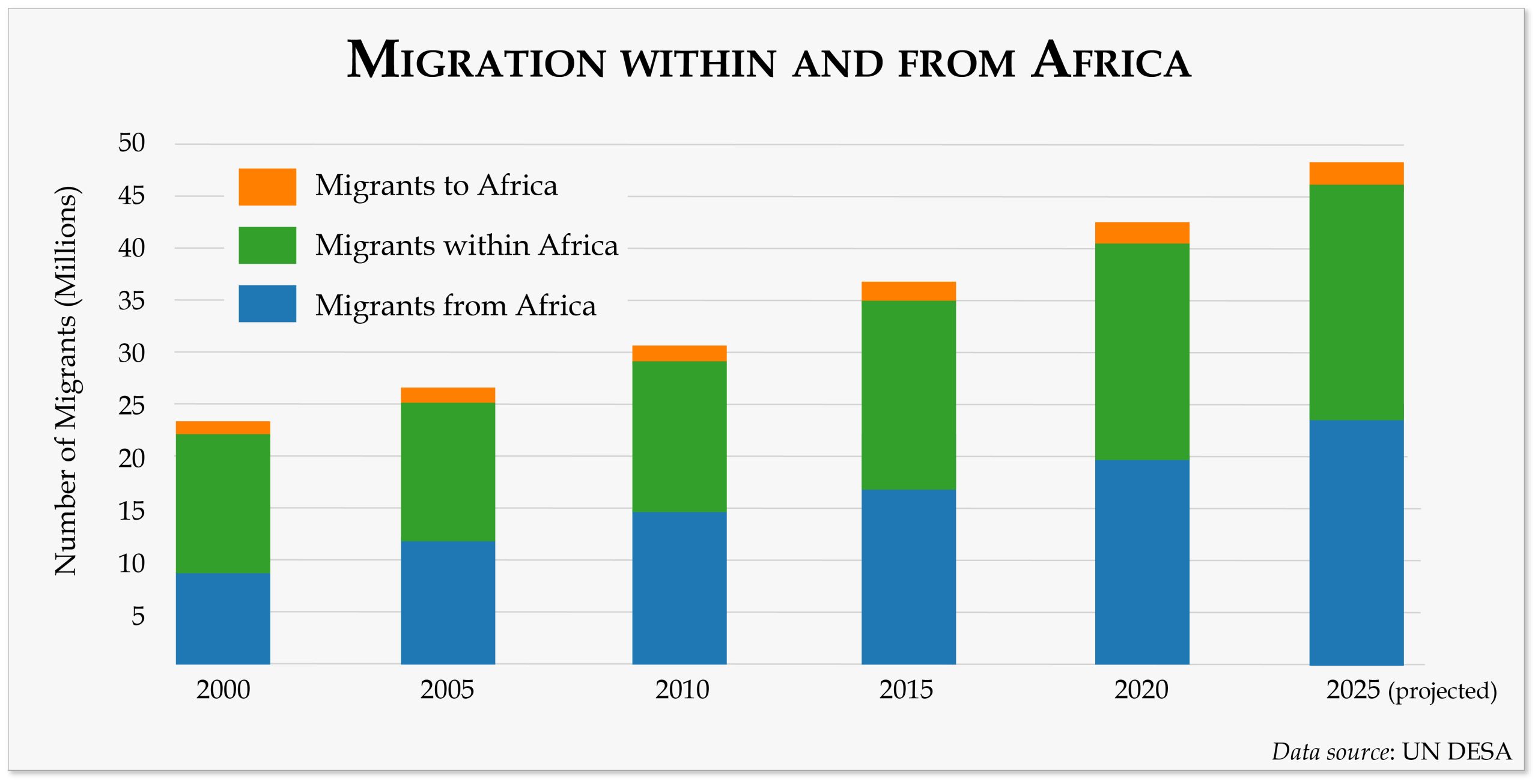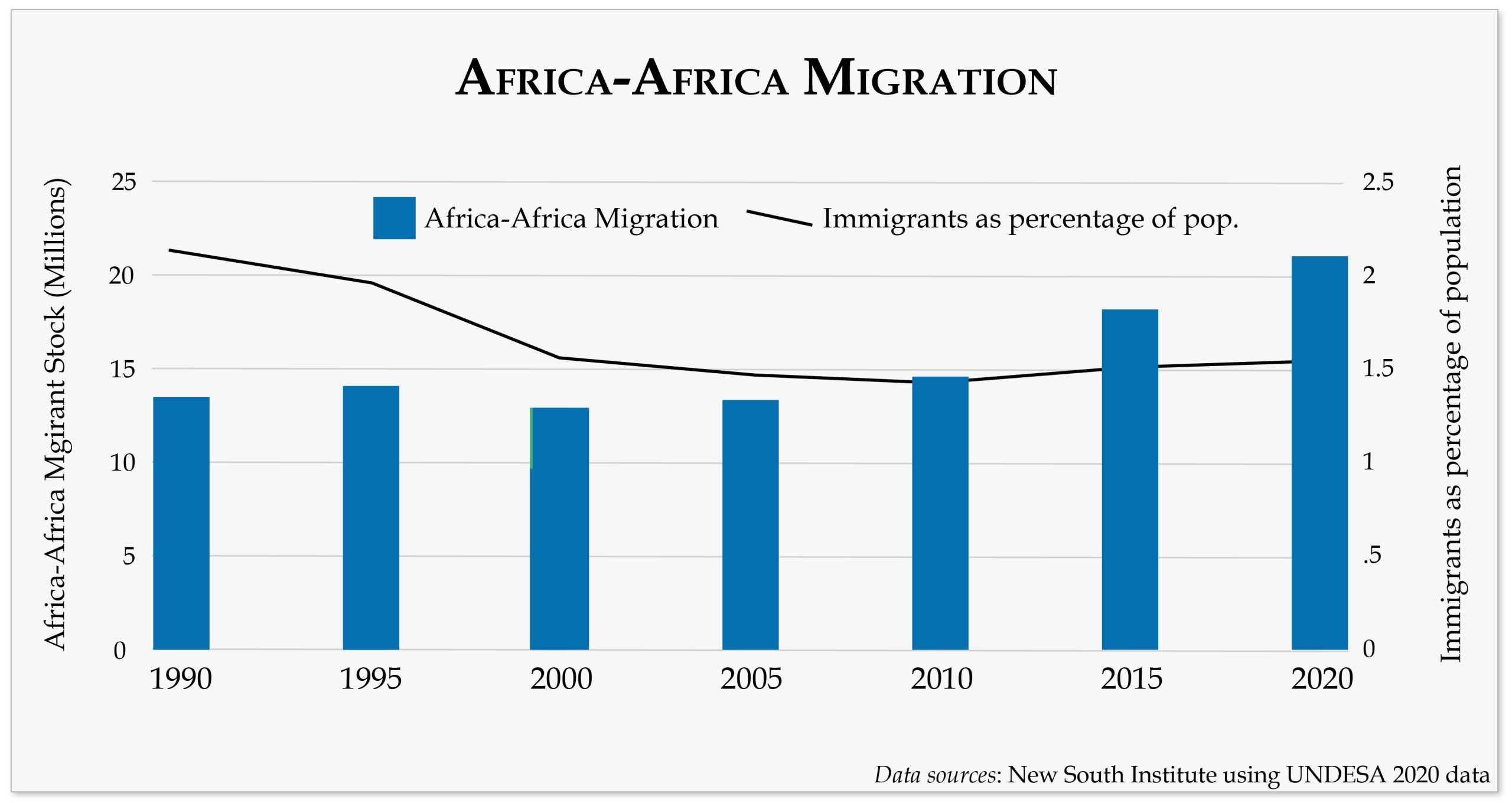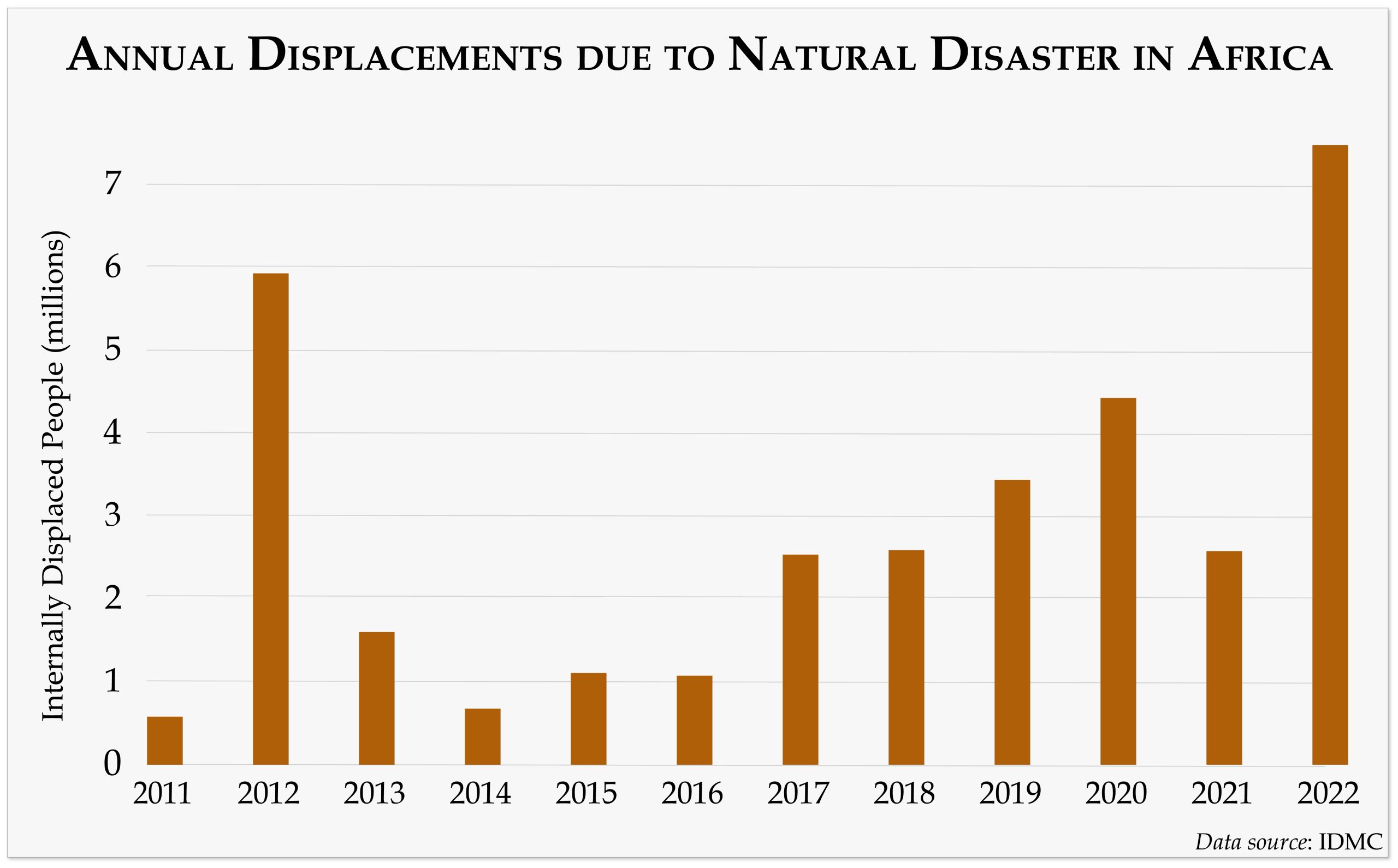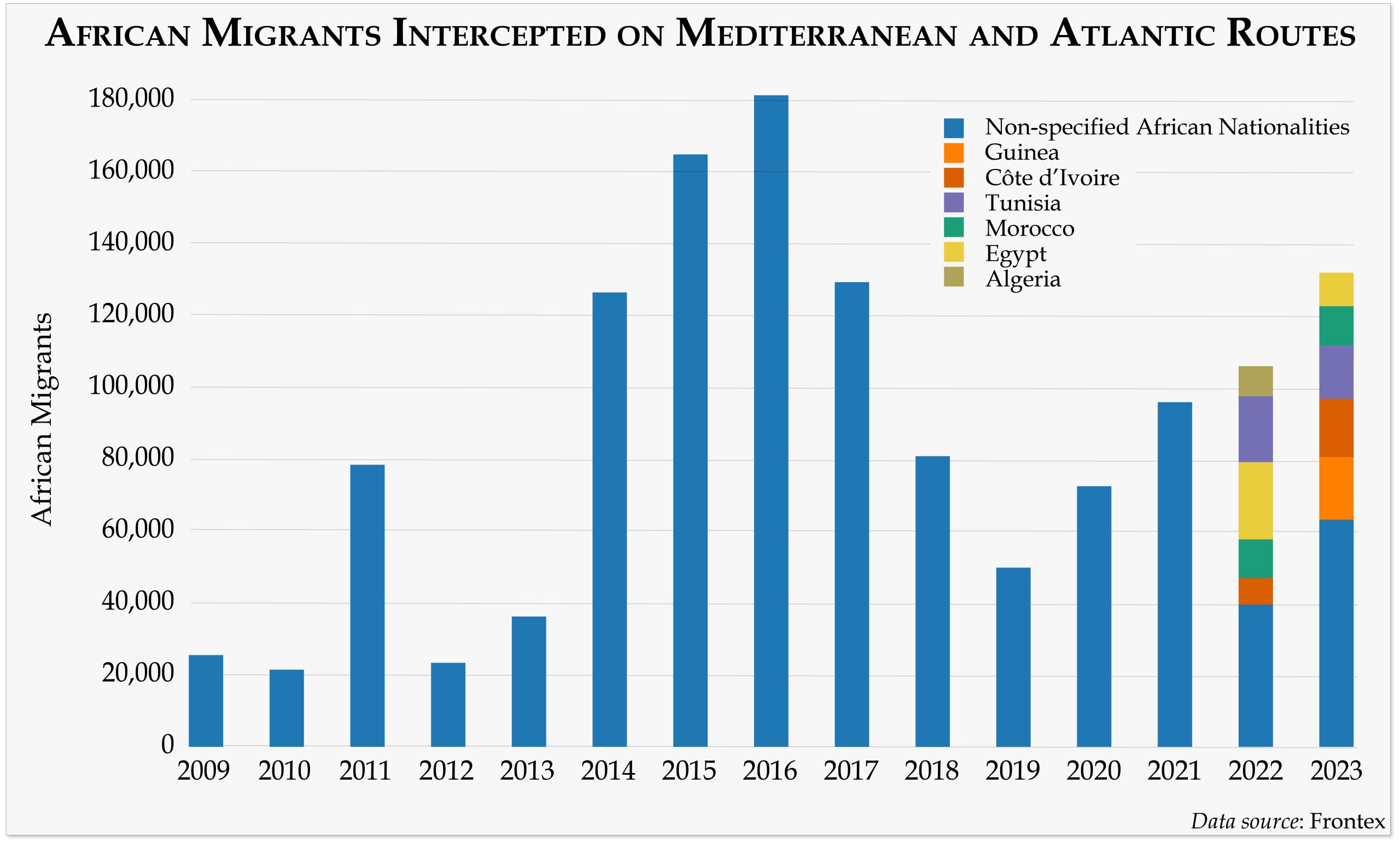
African migrants stranded at the Libyan-Tunisian border in Ras Jedir. (Photo: Mahmud TURKIA / AFP)
African migration continues to experience persistent upward pressures—extending a 20-year pattern. Limited economic opportunity, conflict, repressive government, growing youth populations, and climate change are the primary drivers behind the approximately one million new migrants over the past year. This adds to the estimated 43 million African migrants overall. A majority of these, mostly young and single migrants remain on the continent—seeking employment opportunities in urban hubs. Others seek jobs outside the continent, primarily in the Middle East and Europe, though Africans comprise just 6.6 and 8.2 percent of all migrants in those regions, respectively.
Push Factors Driving African Migration
An estimated 35 percent of people in Sub-Saharan Africa live in poverty creating enormous pressure on income-earning members of households to secure employment to meet basic needs.
- A combination of structural and governance factors are contributing to the steady increase in African migration, which, if current trends persist, will see African cross-border migration reach 11 to 12 million people by 2050.
- While Africa has realized sustained robust economic growth since 2000, the region continues to have the lowest average per capita incomes in the world. An estimated 35 percent of people in Sub-Saharan Africa live in poverty creating enormous pressure on income-earning members of households to secure employment to meet basic needs.
- Most non-conflict driven migration follows seasonal economic opportunities regionally. There has been a 44-percent increase in intra-African migration since 2010. Within the SADC region, most circular migration includes economically dynamic South Africa as a destination. Within ECOWAS, most migrants circulate through Côte d’Ivoire and Nigeria.
- The largest migration in Africa still takes place within countries—mostly circular in nature from rural to urban settings. As sustainable rural livelihoods become more tenuous due to global warming, a growing share of migrants—between 70 and 110 million people—may be forced to make these moves permanent.
- Rural-to-urban migration can be a first step toward international migration as urban migrants gain more income and information about other employment opportunities.
African Migration is Driven by a Combination of Factors
- As the world’s youngest continent, Africa continues to experience more population growth than any other region of the planet. Estimates are that Africa’s population is expected to double from 1.2 billion to 2.5 billion in 2050. Already, 10-12 million African youth join the workforce each year. While fertility rates appear to be dropping faster than previously predicted, Africa is expected to have a high number of employable young people for the remainder of the century.
- Unresolved conflicts on the continent are generating record numbers of forcibly displaced populations. Moreover, reversions to autocratic rule have constricted basic freedoms and heightened the repression that contribute to increased displacements. Extended forced displacement compels young people to move to urban areas—and then potentially off-continent—driving up migration.
Unresolved conflicts on the continent are generating record numbers of forcibly displaced populations.
- The outbreak of conflict between military factions in Sudan in 2023, for example, has generated an additional 6 million cross-border displacements. This adds to the population movements generated by conflicts in South Sudan, the Democratic Republic of the Congo, the Central African Republic, and Somalia, among others.
- Climate change has led to a 34-percent reduction in agricultural productivity growth in sub-Saharan Africa since 1961, which is further contributing to unprecedented food insecurity on the continent in recent years.
- Climate change is predicted to be the driver of up to 10 percent of all African cross-border migration by mid-century. This is largely a result of more severe flooding, drought, and storms. Southern Africa is expected to see the largest increase in cross-border mobility in Africa due to climate change impacts, with between 200,000 to 800,000 people potentially moving to a neighboring country by 2050.
Migration Provides a Lifeline to African Households
- Migration benefits not only countries of destination by filling labor needs but also countries of origin via remittances that contribute to the stability of household incomes in fragile economies, improve food security, and provide access to education.
- Remittance flows to Sub-Saharan Africa have been steadily growing and are a reliable source of support. Remittances to Africa are projected to rise by 3.7 percent in 2024.
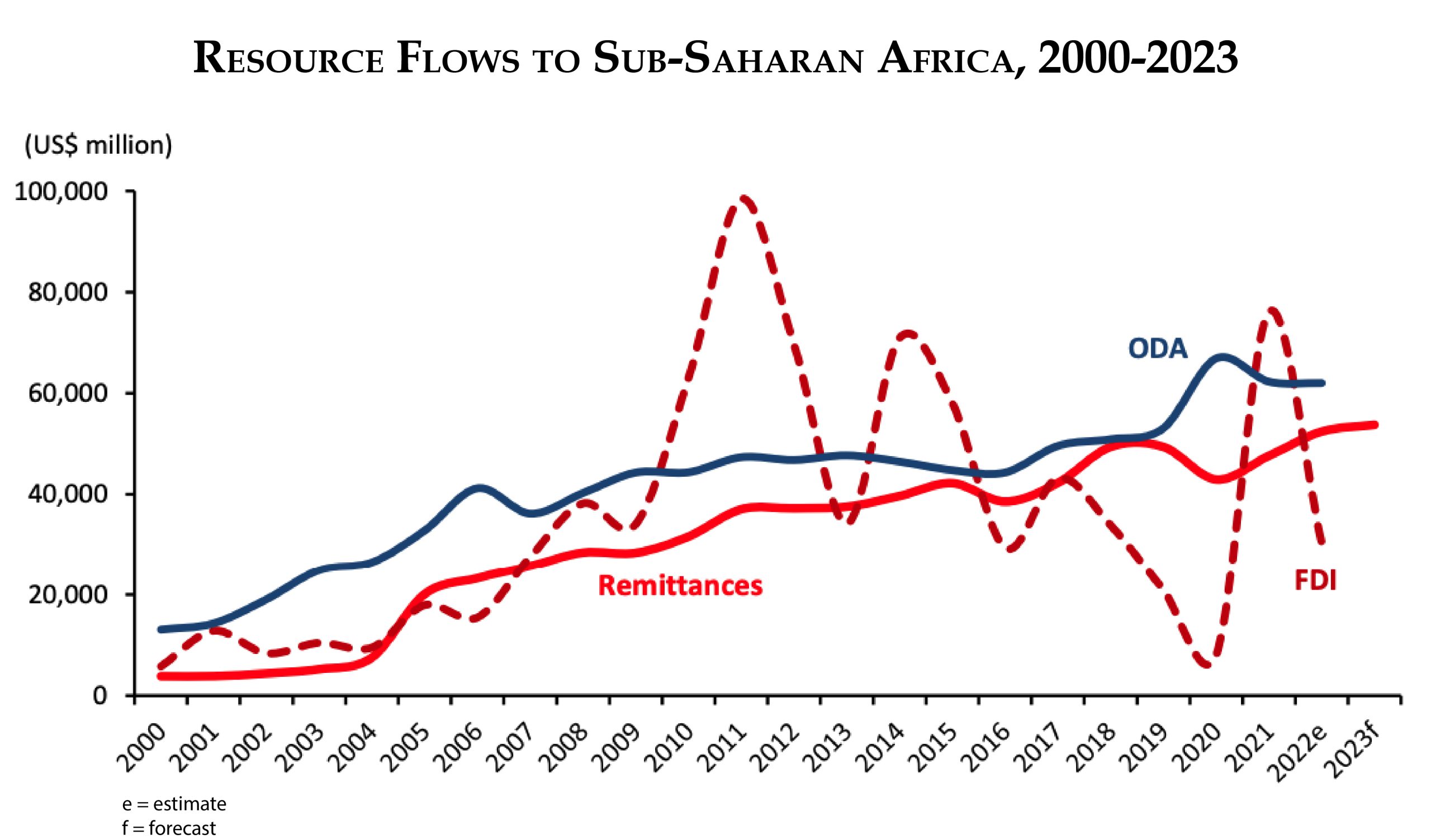
Source: KNOMAD
Irregular African Migration Continues to Entail Considerable Risk
Most reported African migration is via regular channels. The 43 million Africans documented to be living in other countries have some form of legal status. An unknown number of African migrants have resorted to migrating via irregular or clandestine channels. Irregular migration raises vulnerabilities and risks to migrants’ personal security as well as emboldens exploitation of migrants’ lack of legal status by criminal elements.
There are three main irregular migration routes on the continent:
The Eastern Route
The Eastern Route is described as one of the busiest and riskiest migration corridors in the world
- The Eastern Route, described as one of the busiest and riskiest migration corridors in the world, is traveled by hundreds of thousands per year—mostly from Ethiopia, Eritrea, and Somalia. Migrants to the Gulf States expect to earn five times what they could in their country of origin. Approximately 300,000 migrants left Ethiopia for Djibouti and Somalia’s shores in 2023. Over 93,500 migrants from the Horn arrived in Yemen during this period—a 26-percent increase from the previous year. Migration flows along this route are expected to increase in 2024.
- In addition to the life-threatening environmental hazards (such as dehydration, exposure, and drowning), hundreds were killed by Saudi authorities at the Saudi-Yemen border between March 2022 and June 2023. Migrants were shot at close range, subjected to mortar attacks and other explosives, and were raped or forced to rape fellow travelers. Anti-migrant sentiment and a lack of legal protections for migrants remain serious threats in the Gulf States.
The Southern Route
- The Southern Route, along the east coast of Africa toward South Africa via Kenya and Tanzania, does not get as much attention as other irregular migration routes on the continent. However, periodic reports of migrant deaths in the backs of trucks or shipping containers are a reminder of the grim circumstances many experience. An estimated 65,000 used the Southern Route in 2023, a number that is expected to increase in 2024.
- There is growing documentation of various forms of violence and abuse—torture, physical assault, psychological and emotional abuse, and sexual violence—perpetrated by smugglers and other actors on this route.
The Mediterranean and Atlantic Routes to Europe
- The maritime routes toward European shores have received the most attention and scrutiny. The border patrol of the European Union (EU), Frontex, has been accumulating data on intercepted border crossings (IBCs) since 2009. A total of 1.37 million IBCs of African nationals have been made over the last 15 years. This translates into an average of roughly 91,000 IBCs per year.
- While a minority of those attempting to clandestinely cross EU borders, the number of irregular African migrants has been slowly growing in recent years. Nationals from Guinea, Côte d’Ivoire, Tunisia, Morocco, Egypt, and Algeria comprise the top six African sources of IBCs in recent years. Collectively, these countries represent more than half of all African IBCs.
- In the effort to deter Mediterranean crossings, North African countries at the behest of the EU, have attempted to relocate migrants from the coastal cities. At times, these actions have been draconian such as Tunisian authorities deporting and abandoning hundreds of migrants in the desert at the Libyan border. In Libya, migrant homes and workplaces were raided and thousands were forcibly deported into Chad, Egypt, Niger, Sudan, and Tunisia without legal review.
Missing Migrants
- The treacherousness of each of these transit routes is seen by the number who perish—almost 40,000 recorded deaths and disappearances on all African routes since 2014—which is undoubtedly an incomplete figure. The annual number of recorded migrant fatalities is also increasing in recent years—with estimates of 4,300 in 2023.
Innovations to Watch
As Africa’s youthful population continues to generate talented, educated, and restive individuals facing economic pressures, incentives for managing migration to meet labor shortages in countries with shrinking populations will only grow. Following are some emerging developments to monitor.
Continental and Regional Developments
The Regional Economic Communities (RECs) have been important means of dismantling barriers to the movement of people regionally.
- As the Africa Continental Free Trade Area (AfCFTA) takes shape, African countries will be giving greater attention to the issue of migration and how it can be facilitated to generate greater economic dividends.
- 50 African countries improved or maintained their Africa Visa Openness Index score in 2023, according to the African Development Bank (ADB). Forty-two countries now extend visa-free entry to citizens from at least 5 other African countries, and 33 countries offer the same to at least 10 other countries.
- In 2023, Rwanda joined The Gambia, Seychelles, and Benin in the fraternity of countries committed to offering visa-free access to all Africans. While still a long way from the 2018 African Union Free Movement of Persons protocol’s aim of pan-African movement for Africans, this reflects momentum in that direction.
- The Regional Economic Communities (RECs) have been important means of dismantling barriers to the movement of people regionally. The ADB found that the average visa openness has improved in six of the eight RECs over the past year with ECOWAS continuing to lead the way.
National Developments
- South Africa issued a long awaited white paper on overhauling the immigration system in 2023. Among the proposed changes was a “trusted employer” scheme (qualified employers can avoid lengthy and costly administrative requirements), an electronic system for study, business, and intracompany transfer visas, a national identification and registration system, and the establishment of one-stop centers to manage the movement of people and goods at land borders.
- The Nigerien junta rescinded the 2015 anti-smuggling law. The junta’s actions may revitalize the well-known migration route through Niger, increasing the number of migrants going to Libya where migrants are regularly targeted by criminals and militias.
- Senegal passed a National Strategy to Combat Irregular Migration in 2023 to reduce irregular migration by 2033. The EU provided Senegal with $9.9 million—part of which went toward a new headquarters for Senegal’s air and border police—to stop irregular migration. Lacking other human security measures, this approach, like those in Niger and on the central Mediterranean coast, may increase interdictions as well as make crossings more dangerous—as increasing death and missing reports indicate.
Regularizing Intercontinental Migration
- To make it easier for African nations to adopt laws and policies that match their particular contexts, the United Nations Network on Migration launched the CLIMB Database: Human Mobility in the Context of Disasters, Climate Change and Environmental Degradation Database. This is a collection of 1,808 policies and laws designed to address the challenges of migration governance. This initiative aims to standardize and help ensure population movements are orderly, safe, and regular.
- Bilateral cooperation can be optimized to match migrants’ skills and attributes with the needs of destination economies that would maximize the development impacts of cross-border movements. This approach enables policy makers to distinguish between types of population movements and to design migration policies for each.
- Egypt and Greece have signed a bilateral deal inviting up to 5,000 seasonal farm workers from Egypt to Greece for up to 9 months to fill a shortage of at least 30,000 jobs in the sector.
International partners can further support mutually beneficial migration efforts by improving data collection on African population and migration patterns.
- Ethiopia hosts over 950,000 refugees and asylum seekers—reflective of the pattern of migrants often first traveling to neighboring, low-income countries. In order to better support Ethiopia’s efforts to host these populations, international development partners have invested in Ethiopia’s industrialization efforts, creating over 100,000 jobs for Ethiopians and refugees residing in the country. Under the Ethiopia Job Compact, the EU matched support for job creation in Ethiopia to the gradual relaxation of the limitations on labor market access for 30,000 refugees.
- International partners can further support mutually beneficial migration efforts by improving data collection on African population and migration patterns. Better information can then improve the political, regulatory, and financial regimes in African countries to attract more foreign direct investment and jointly reduce levels of irregular migration.
Climate Mobility to Elevate Interest in Revamping Migration Policy
Migration into already fragile places risks heightening tensions around land and water resources.
- Migration into already fragile places risks heightening tensions around land and water resources. With trends showing growing climate migration, African countries have incentives to anticipate these movements and invest in inclusive climate-resilient strategies.
- Scenarios of internal climate-driven mobility identify prospective “hotspots” of geographic areas from which high concentrations of departing and arriving populations are expected. Notably, displacements are anticipated within each region of the continent. Under some scenarios, up to 5-percent of Africa’s population could be on the move due to climate impacts by 2050, up from 1.5 percent today.
African Mobility Hotspots
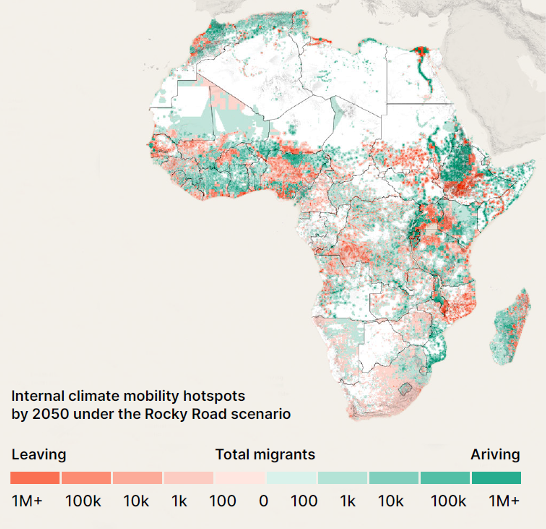
Source: ACMI Africa Climate Mobility Model, 2022
Additional Resources
- Chris Horwood and Bram Frouws, eds., “Mixed Migration Review 2023,” Mixed Migration Centre, 2023.
- World Bank, World Bank Development Report 2023: Migrants, Refugees, and Societies (Washington, DC: World Bank, 2023).
- Michael Mutava, “An Analysis of Trends and Patterns of Migration in Africa,” New South Institute, October 2023.
- Africa Center for Strategic Studies, “African Migration Trends to Watch in 2023,” Infographic, January 9, 2023.
- Wendy Williams, “Shifting Borders: Africa’s Displacement Crisis and Its Security Implications,” Africa Center Research Paper No. 8, Africa Center for Strategic Studies, October 2019.
More on: Migration and Forced Displacement


